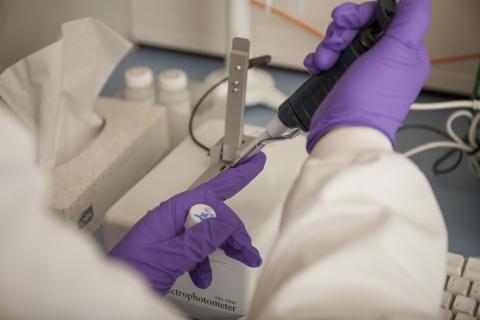New findings from Anthony Nolan’s flagship Patient/Donor project have shown that sometimes a perfect match isn’t always successful, and sometimes other matches are.
For over 20 years, Anthony Nolan has been collecting DNA samples from stem cell recipients and their matched donors. The project now has over 2,500 pairs of samples from more than 40 UK transplant centres. In collaboration with the British Society for Blood and Marrow Transplantation (BSBMT), we have collected clinical data over this period to see which matches were more successful and which ones caused complications such as graft versus host disease (GvHD) and relapse.
Nearly 900 paired donor and recipient DNA samples have been re-analysed using TGS to see if the new technology can provide better insight into why some matches were more successful.
In a quarter of cases, TGS revealed mis-matches between the donor and recipient that were not seen when the match was first made. This is because it can look at the DNA in much more detail.
This study focused on the patients that were originally given a perfect match – a 12/12 score for all six HLA genes, which also includes DPB1. After TGS analysis, those patients that still had a perfect score were approximately twice as likely to be alive after five years compared to those that were now 10/10, but had certain mismatches in DPB1.
The study confirmed previous findings that some DPB1 mismatches can have a better outcome for patients than others. Similarly, the 12/12 patients were less likely to experience serious complications in the 12 months post-transplant. Patients with mismatches in DPB1 were also twice as likely to develop acute GvHD after their transplant.
Importantly, this new TGS data has been combined with other factors that we know can influence transplant success. This included matching the patients and donors for cytomegalovirus (CMV) status – a very common virus that causes few complications in healthy individuals. This improved the probability of patient survival by threefold, when compared to patients with a 10/10 score and CMV mismatch.
Dr Neema Mayor, Senior Post-Doctoral Research Scientist at Anthony Nolan, said: ‘We are very excited about this breakthrough which has told us more than we have ever known about how to match patients and donors and the clinical impact of this study is considerable. Matching in this way means we will be able to minimise the risk of complications such as graft-versus-host disease and, consequently, the risk of mortality – potentially saving more lives.
‘There is a lot to celebrate however long term survival rates remain unacceptably low, which will keep driving us forward with further research. Anthony Nolan was the world’s first stem cell registry when it was founded nearly 45 years ago and, after four decades of saving lives, we remain a pioneering organisation. Our commitment to saving lives determines our research agenda, and we will continue to ensure findings are reflected in clinical practice and decision-making.’
58-year-old Ruth Crabtree is a Farmer and B&B owner from Derbyshire. In March 2010 Ruth started to experience severe allergic reactions to plants, and became lethargic. Ruth visited her GP, who referred her for tests, which revealed she had leukaemia. Ruth, a mother of one, received a stem cell transplant from a stranger in March 2011, at which time she joined the Anthony Nolan Patient/Donor Project, a long term study which could revolutionise the way that patients and donors are matched.
Ruth says: ‘I received four rounds of chemotherapy which didn’t work very well. In March 2011 I was well enough to receive a stem cell transplant. I was told that Anthony Nolan had found three potential donors. I was lucky because of my background. My donor was a 12/12 match and it’s been eight years since my transplant, and I’ve not had many problems.’
Of the stranger who donated stem cells Ruth says: ‘That person – whoever it is – is absolutely wonderful. I think about him every now and again, because there are a few things that have changed for me after my transplant. Before my transplant I couldn’t eat shell fish –I can now!
‘I wanted to be part of this study because I hope the findings will enable more people to be as lucky as I have been. And if allowing researchers to learn more about leukaemia and stem cell transplants can make treatments better for people in the future I’m happy to do so.’
Professor Steven Marsh, Director of Bioinformatics at Anthony Nolan, added:
‘Anthony Nolan was the world’s first stem cell registry when it was founded more than 40 years ago. Our work with this new high-resolution sequencing shows that, even after four decades of saving lives, we remain a pioneering organization.
‘By investing in what we believe to be the gold standard of tissue typing, we have once again shown our commitment to improving the lives of people with blood cancer. We look forward to a bright future for Anthony Nolan and for stem cell transplant patients and we firmly believe this new TGS will be an important part of that goal.’
Read ‘Recipients Receiving Better HLA-Matched Hematopoietic Cell Transplantation Grafts, Uncovered by a Novel HLA Typing Method, Have Superior Survival: A Retrospective Study’ here.
